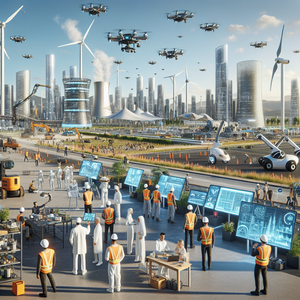
The Future of Construction Jobs in 2025: Opportunities in a Transforming Industry
The construction industry is gearing up for a pivotal year in 2025, as it faces a dual challenge: addressing a significant labor shortage while embracing groundbreaking trends that are reshaping its landscape. With an estimated need for nearly half a million additional workers to meet growing demands, the sector is under pressure to adapt. Driving these shortages are factors such as a retiring workforce, a skills gap among younger workers, and a backlog of projects delayed by the pandemic and economic shifts. At the same time, emerging opportunities in sustainability, advanced technology, and infrastructure investment are creating a dynamic environment for professionals looking to build or advance their careers in construction.
Job Summaries:
Labor Shortages and Wage Growth:
- By 2025, the construction industry is projected to face a labor shortfall of approximately 439,000 workers.
- This shortage is driven by the aging workforce, insufficient training pipelines for younger workers, and a surge in infrastructure and housing projects.
- Companies are offering higher wages, signing bonuses, and enhanced benefits to attract skilled professionals.
Technology Driving Efficiency:
- Technology is playing a transformative role in construction.
- Tools like Building Information Modeling (BIM), drones, artificial intelligence (AI), and advanced robotics are streamlining workflows and reducing errors.
- This shift is creating new opportunities for digitally skilled workers, including BIM specialists and drone operators, who are essential for modernizing construction processes.
Sustainability as a Priority:
- With stricter environmental regulations and increasing client demand for eco-friendly buildings, sustainability is central to competitive construction practices.
- From energy-efficient materials to renewable energy systems, green building is driving demand for roles like sustainability consultants and green building architects.
Infrastructure Investments:
- Governments worldwide are ramping up funding for large-scale infrastructure projects, including roads, bridges, and public transportation systems.
- This trend is fueling demand for civil engineers, construction equipment operators, and project managers with expertise in large, complex projects.
Upskilling and Training Initiatives:
- To bridge the skills gap, many companies are investing in vocational training and upskilling programs.
- These initiatives aim to attract younger professionals while equipping the workforce with the technical knowledge needed to meet modern construction demands.
Carpenter:
- Carpenters are fundamental to construction, responsible for building frameworks, walls, floors, and more.
- With demand for both residential and commercial spaces on the rise, skilled carpenters are critical to keeping projects on track.
- Persistent labor shortages and a housing boom ensure steady, well-paying opportunities for carpenters.
Construction Project Manager:
- Project managers oversee every aspect of a construction project, ensuring it stays on schedule and within budget.
- Their leadership is essential for navigating workforce challenges and maintaining efficiency.
- The growing complexity of projects calls for experienced managers who can juggle multiple priorities.
Sustainability Consultant:
- Sustainability consultants guide companies in adopting eco-friendly practices.
- They recommend energy-efficient materials.
- They design renewable energy systems.
- Sustainability is becoming a cornerstone of modern construction.
- These consultants are indispensable for meeting regulations.
- They are essential for addressing market demands.
Construction Equipment Operator:
- Operators of heavy machinery like bulldozers and cranes play a vital role in preparing construction sites and moving materials safely and efficiently.
- A shortage of skilled operators makes this a high-demand role, with competitive pay to match.
Building Information Modeling (BIM) Specialist:
- BIM specialists use advanced software to create 3D models of construction projects.
- They improve collaboration and identify potential design issues.
- As technology reshapes workflows, BIM specialists are vital for streamlining project planning and execution.
Green Building Architect:
- Green building architects focus on designing energy-efficient structures that incorporate renewable energy systems, water-saving features, and sustainable materials.
- With sustainability at the forefront of the industry, green architects are helping companies remain competitive.
Drone Operator:
- Drone operators provide critical aerial views for site surveys, inspections, and progress tracking, reducing costs and improving accuracy.
- Drones are revolutionizing construction efficiency, making operators indispensable.
Civil Engineer:
- Civil engineers design and manage large-scale infrastructure projects, such as bridges, highways, and water systems.
- Increased government funding for public works projects has significantly boosted demand for these professionals.
HVAC Technician:
- HVAC technicians ensure buildings maintain efficient heating, cooling, and ventilation systems.
- Growing emphasis on energy efficiency.
- Energy-efficient systems becoming standard.
- HVAC technicians are essential to modern construction.
The construction industry in 2025 is brimming with opportunities for professionals across diverse roles. From traditional trades like carpentry to cutting-edge fields like BIM and drone operation, there’s a place for nearly every skill set. The sector’s focus on sustainability, technology, and infrastructure investment makes it an exciting time to enter or advance in construction. With the right preparation, you can carve out a fulfilling career in a field that’s not only evolving but also shaping the future.
Explore More Jobs

